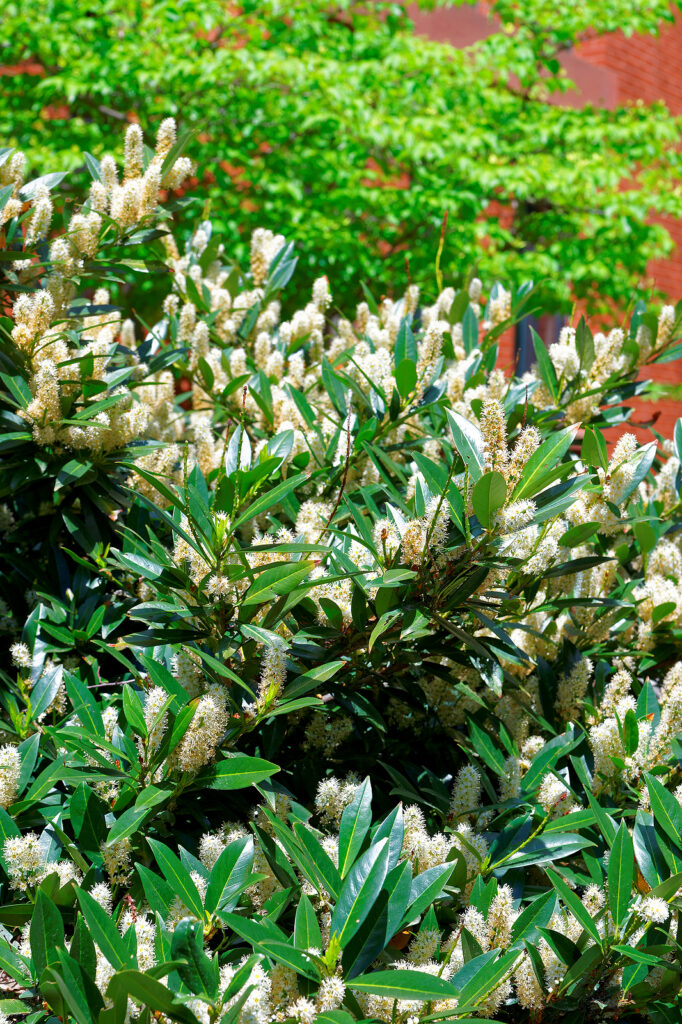Itea — commonly called sweetspire or Virginia sweetspire– bears catkin-like panicles of small white flowers. There is both an evergreen and deciduous variety of Itea; both have handsome holly-like leaves but otherwise are not too similar. The deciduous variety bears colorful fall foliage.
Itea is a genus of about 10 species. Sweetspire prefers moist soil and is best grown in shrub or mixed border.

Get to know Itea
- Plant type: Deciduous shrub
- Growing zones and range: Zones 5 to 9.
- Hardiness: Hardy to Zone 5
- Height and width: 5 to 10 feet (1.5-3m) tall and wide
- Foliage: An upright-then-arching form; either evergreen leaves similar to Holly’s (Ilex) or deciduous leaves with colorful fall foliage–those green leaves turn purple to red in fall.
- Flowers: Creamy white fragrant flowers in narrow clusters up to 6 inches (15cm) long.
- Bloom time: Summer
- Uses: Shrub border or woodland planting.
- Garden companions: European cranberry bush (Viburnum opulus)
- Common name: Virginia sweetspire
- Botanical name: Itea
- Family name: Grossulariaceae
- Origin: Eastern United States and East Asia
Where to plant Itea
- Plant Itea in full sun or light shade.
- Plant Itea well-drained, moist, humus-rich, somewhat acidic soil.
- Plant Itea where it is not in drying winds.
When to plant Itea
- Set container-grown Itea in the garden in spring or fall.
- Sw seed in spring or sow Itea seed when it is ripe.
Planting and spacing Itea
- Space Itea 5 to 10 feet (1.5-3m) apart depending on the variety.
- Sow seed 1/4 inch deep in evenly prepared soil.
- Itea is easily started from cuttings or suckers.

How to water and feed Itea
- Give Itea regular water.
- Fertilizer Itea with an all-purpose, organic fertilizer in spring,
How to care for Itea
- Tie in long shoots of wall-trained Itea.
Itea pests and diseases
- Itea rarely have diseases or pests.
Itea propagation
- Take Itea softwood cuttings in late spring.
- Root semi-ripe cuttings in summer.
Itea varieties to grow
- Itea ilicifolia, hollyleaf sweetspire: a Chinese evergreen that grows 10 to 12 feet (3-4m) tall and is graceful, open, and arching; it has spiny, lustrous, dark green hollylike leaves 2 to 4 inches (5-10cm) long; leaves are bronze-red when new, maturing to dark green; tiny greenish-white flowers appear in slender racemes that are nodding or drooping to 1 foot (.3m) long, from mid-to-late summer; flowering is sparse where winters are mild; this variety needs fertile, moist soil in partial shade and out of the wind and requires minimal pruning; attractive near water or espaliered along a fence or wall. Zones 8 to 9.
- I. virginica, Virginia sweetspire, an eastern U.S. wetland plant growing erect up to 5 feet (1.5m) tall and easily suckering twice as wide; spreads to form large patches where well adapted; this species is adaptable to drought and almost any other hardship, although it flowers and colors best in moist, fertile soil and full sun; leaves are oval, dark green, to 4 inches (10cm) long and 1.5 inches (3.7cm) wide; autumn foliage can be a spectacular mix of red and reddish-purple, sometimes with orange or yellow; fragrant creamy white flowers are held in clusters; bloom in the spring in the South, in summer farther north; ecellent planting at the edge of a wood or pond, or in a border; cut back one-third of oldest shoots to stimulate new growth. Cultivar ‘Henry’s Garnet’, which received a Gold Medal from the Pennsylvania Horticultural Society, has larger flowers—6 inch (15cm) clusters—and spectacular fall color; only 4 feet (1.2m) tall; best in Zones 6 to 9.















